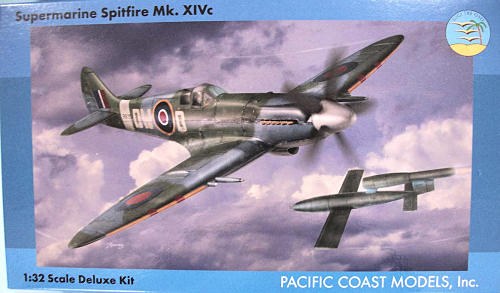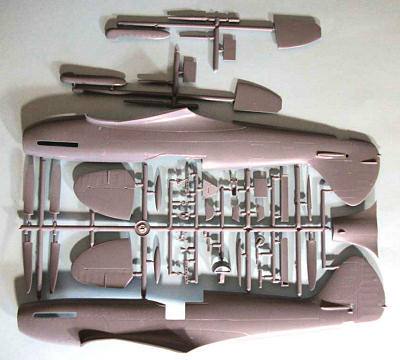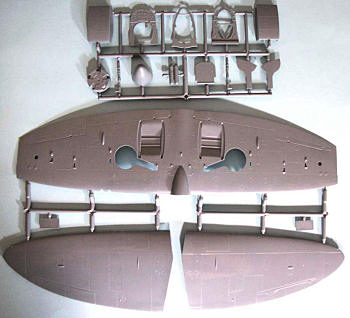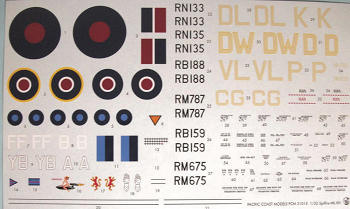Pacific Coast 1/32 Spitfire XIVc/e
|
KIT #: |
32015 |
|
PRICE: |
$69.95 SRP |
|
DECALS: |
Seven options |
|
REVIEWER: |
Tom
Cleaver |
|
NOTES: |
|

Development of the Spitfire to use the more powerful
Rolls‑Royce Griffon engine began in late 1940 with the Type 337.
Extensive airframe modification to absorb the additional
power was necessary.
In order to gain further experience with the Griffon‑61,
six Mk. VIII airframes were modified.
Experience with these showed it would be possible to
create a Griffon‑powered high‑altitude air superiority fighter in a faster time
frame than envisioned with the Spitfire XXI by mating the Griffon to the Mk.
VIII airframe the way the Merlin‑61 had been mated to the Spitfire V.
Thus, third major development of the Spitfire saw the
“interim” type produced in larger numbers and used more widely than the version
developed specifically to use the more powerful engine.
The Spitfire XIV, utilized a “beefed‑up” Mk. VIII
airframe with larger radiators.
The first squadron to re-equip with the new type was
610, a former RAuxAF squadron which had been among the first equipped with the
original Spitfire.
The Mk. XIVs arrived in January 1944. 610 gave a public
display of their new mounts in mid‑May 1944 and managed a few fighter sweeps
before D‑Day.
The Spitfire XIV was intended to provide high altitude
air superiority, to complement the medium‑altitude Tempest V.
Both types saw
their entry into air combat over the Continent following D‑Day delayed by the
deployment of the Fi‑103 “buzz bomb,” the first of which exploded in
England
two days after the invasion.
It was quickly ascertained that the best defense against
these robots were standing patrols by the fastest Allied fighters.
Over the course of the anti‑diver campaign, which only
ended when the launch sites in Belgium were overrun by the Allied armies in
September 1944, the Spitfire XIV emerged as the most successful of all Spitfire
types in destroying the “buzz bombs,” being flown by two wings at the time, with
a third re‑equipping just at the end of the campaign.
The Mk. XIV arrived on the Continent at about the same
time the Luftwaffe re‑equipped with the Fw‑190D‑9.
The Spitfire XIV had superior performance above 25,000
feet, but most fights over the Western Front were occurring at lower altitudes.
Thus, as had been the case with the Spitfire since the
first introduction of the Fw‑190, the new version just maintained superiority
over the latest 190, with pilot quality (declining for the Germans) being the
deciding element.
By V‑E Day, 20 RAF squadrons were equipped with the
Spitfire XIV in
Europe,
and the type had arrived in the Southeast Asia Theater.
While Spitfire squadrons quickly re‑equipped with the
new airplane, the Pacific War came to a fast end before they could enter combat.
 There have been three Spitfire XIV kits released in 1/72
scale and two, by Academy and Hobbycraft, in 1/48.
None have been entirely “right.”
This kit by Pacific Coast Models is the first
injection-molded Spitfire XIV in 1/32, and is the only Spitfire XIV kit in any
scale to get the external dimensions right.
There have been three Spitfire XIV kits released in 1/72
scale and two, by Academy and Hobbycraft, in 1/48.
None have been entirely “right.”
This kit by Pacific Coast Models is the first
injection-molded Spitfire XIV in 1/32, and is the only Spitfire XIV kit in any
scale to get the external dimensions right.
As with other PCM limited-release kits, the model is
relatively simple in production design, with a nicely-detailed cockpit and good
decals by Cartograf for several different aircraft. After the release of the
Tamiya Spitfire IX, some modelers said that the PCM kits were superfluous, but
in fact I can sit my Tamiya Spitfir e
IX next to my PCM Spitfire IX, and from a distance greater than a foot there are
no obvious external differences.
Yes, the Tamiya kit has greater detail, but the PCM kit
is entirely acceptable, and this one is too.
Given that Tamiya is going to be involved over the next
few years with the release of a later-version P-51D, the P-51B/C and the “next
big thing” (smart money is betting on an F4U-1 Corsair series), this Griffon
Spitfire from PCM is going to be what's there for Spitfire modelers who tire of
doing the hyper-expensive Tamiya Merlin-60 series fighters.
e
IX next to my PCM Spitfire IX, and from a distance greater than a foot there are
no obvious external differences.
Yes, the Tamiya kit has greater detail, but the PCM kit
is entirely acceptable, and this one is too.
Given that Tamiya is going to be involved over the next
few years with the release of a later-version P-51D, the P-51B/C and the “next
big thing” (smart money is betting on an F4U-1 Corsair series), this Griffon
Spitfire from PCM is going to be what's there for Spitfire modelers who tire of
doing the hyper-expensive Tamiya Merlin-60 series fighters.
The kit has the best prop blades for a Griffon Spitfire
I have seen in an injection-molded kit.
The radiators are the proper size and shape (which has
been problematic with other kits).
 The one complaint I have is that the decals and profiles
were created by the well-known artist, Richard Caruana, who makes his usual lazy
mistakes.
Most prominently, he completely botches the Spitfire XIVe flown
by Ginger Lacey, opting to create the restored 1980s warbird originally flown by
The Fighter Collection at Duxford and today owned by Cinema Air in Texas.
For the record, Lacey's airplane was not in Dark Earth
and Dark Green, and did not have clipped wingtips.
As with all other “high-back” Spitfire XIVs sent to
SEAC,
the airplane was in the standard Dark Green/Ocean Grey/Sea Grey Medium, with the
standard European national insignia overpainted in Dark Green.
This is obvious to anyone who takes five minutes to look
at the several pictures available of this airplane.
I am not saying here that the decals are the problem; they are fine and dandy.
The markings for all options are right, the colors are right, all is well with
the world as regards the decal sheet. What I
am upset about is the failure to do proper research
about the PAINT SCHEME.
If one does the Ginger Lacey airplane in the correct paint scheme (like the 132
Squadron airplane), the decals will be just fine on it.
The one complaint I have is that the decals and profiles
were created by the well-known artist, Richard Caruana, who makes his usual lazy
mistakes.
Most prominently, he completely botches the Spitfire XIVe flown
by Ginger Lacey, opting to create the restored 1980s warbird originally flown by
The Fighter Collection at Duxford and today owned by Cinema Air in Texas.
For the record, Lacey's airplane was not in Dark Earth
and Dark Green, and did not have clipped wingtips.
As with all other “high-back” Spitfire XIVs sent to
SEAC,
the airplane was in the standard Dark Green/Ocean Grey/Sea Grey Medium, with the
standard European national insignia overpainted in Dark Green.
This is obvious to anyone who takes five minutes to look
at the several pictures available of this airplane.
I am not saying here that the decals are the problem; they are fine and dandy.
The markings for all options are right, the colors are right, all is well with
the world as regards the decal sheet. What I
am upset about is the failure to do proper research
about the PAINT SCHEME.
If one does the Ginger Lacey airplane in the correct paint scheme (like the 132
Squadron airplane), the decals will be just fine on it.
Additionally, the seat is based on that from the
Hasegawa 1/32 kit, which is too big.
If that's important to you, it can be cut down, or
replaced with a resin seat from either Greymatter figures or Barracuda Studios.
I personally have never been put off by the seats in my
Hasegawa 1/32 kits or the PCM Spitfire IX, which also uses that seat.
Definitely the best Spitfire XIV released by anyone, and
a nice simple kit that will build into an excellent model with a moderate amount
of “some modeling skill required”.
It flies to the top of my “to do” pile.
Tom Cleaver
September 2011
Review
kit courtesy of Pacific
Coast Models.
If you would like your product reviewed fairly and fairly quickly, please contact the editor or see other details in the
Note to
Contributors.
Back to the Main Page
Back to the Previews Index Page


 There have been three Spitfire XIV kits released in 1/72
scale and two, by Academy and Hobbycraft, in 1/48.
None have been entirely “right.”
This kit by Pacific Coast Models is the first
injection-molded Spitfire XIV in 1/32, and is the only Spitfire XIV kit in any
scale to get the external dimensions right.
There have been three Spitfire XIV kits released in 1/72
scale and two, by Academy and Hobbycraft, in 1/48.
None have been entirely “right.”
This kit by Pacific Coast Models is the first
injection-molded Spitfire XIV in 1/32, and is the only Spitfire XIV kit in any
scale to get the external dimensions right. e
IX next to my PCM Spitfire IX, and from a distance greater than a foot there are
no obvious external differences.
Yes, the Tamiya kit has greater detail, but the PCM kit
is entirely acceptable, and this one is too.
Given that Tamiya is going to be involved over the next
few years with the release of a later-version P-51D, the P-51B/C and the “next
big thing” (smart money is betting on an F4U-1 Corsair series), this Griffon
Spitfire from PCM is going to be what's there for Spitfire modelers who tire of
doing the hyper-expensive Tamiya Merlin-60 series fighters.
e
IX next to my PCM Spitfire IX, and from a distance greater than a foot there are
no obvious external differences.
Yes, the Tamiya kit has greater detail, but the PCM kit
is entirely acceptable, and this one is too.
Given that Tamiya is going to be involved over the next
few years with the release of a later-version P-51D, the P-51B/C and the “next
big thing” (smart money is betting on an F4U-1 Corsair series), this Griffon
Spitfire from PCM is going to be what's there for Spitfire modelers who tire of
doing the hyper-expensive Tamiya Merlin-60 series fighters.